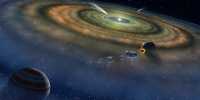Thanks to NASA’s Chandra X-ray Observatory for the first X-ray detection from NASA Uranus. The seventh planet in the solar system is classified as an ice giant along with Neptune and so far these were the only two planets from which X-rays could not be detected. The new paper, published in the journal Geophysical Research Space Physics, looked at three observations made by the moon over the past two decades, one from August 7, 2002 and two between November 11 and 12, 2017.
The identification only became apparent when the data was recently re-analyzed. Older observations clearly show a signal, and in more recent times, the signal points to something sooner. Not three observations but they are providing some new insights about Uranus. The team believes that most X-rays seen do not come from Uranus but some may be. The main source of this light is none other than the Sun. Just as the Earth’s atmosphere emits visible light, so does the atmosphere of the solar system’s giant planets like Jupiter and Saturn scatter X-rays all of them.
Researchers believe that the same process is happening with Uranus. But there may be more. There are indications that some of the X-rays observed are not only scattered from the sun but are produced by the planet. One possible source may be the ring of Uranus. Not as spectacular as Saturn itself, the planet contains up to a fraction of a meter (a few feet) of rings formed by dark particles between a few microns.
Saturn’s rings emit X-rays so that the same thing happens here. The alternative is aurorae. North and south lights are not exclusive to Earth where they are caused by electrons hitting the atmosphere. Charged atoms and molecules have similar effects on Jupiter.
Charged atoms and molecules have similar effects on Jupiter. It is unknown at this time what he will do after leaving the post. However, this can be an important factor in understanding this mysterious planet better. As the planets go, Uranus is more complex than we are. It revolves around its side, so day and night it does not coincide with the axis. This is probably due to its huge influence in the past. And the result is a strange magnetic field.
If we imagine a magnetic field like a bar magnet, we see that it does not go through the center of a planet like Earth, it is a little farther from the side. And it points in a completely different direction compared to the axis of rotation. Further observations will be needed to understand exactly where the X-rays of Uranus came from.















